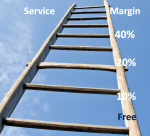What is your customer engagement ladder?
The lean approach to sales is seeing customers as friends: we help them get done what they want to get done, with the lowest cost and hassle possible, they help us stay in business by accepting our prices.
But how does one build this kind of relationships? As with friends, some favors are free, some are deals.
- Free favors: there are two kinds of free favors – either a one off helping hand to establish as an ice-breaker, or a service as between old friends, a reward for loyalty.
- Good and bad deals: good deals are those where the customer is happy and lets you make a living, bad deals are those where either the customer is unhappy because they feel scammed, or they’re happy but won’t let you live at your price, or both.
The idea, of course, is to move relationships from free service as icebreakers, to a space where mutually beneficial win-win deals can be found routinely, which also makes it easier to throw in the occasional free service as part of mutual help.
The danger is in over doing the early engagement stuff; acquiring new customers is much more expensive than working with existing ones. Or, worse, to stabilize the relationship in a place where the done deal only leaves you room to scrap buy.
There is no set way of figuring this out, but a starting point can be drawing a ladder of engagement, from the early contact services and how much margin these bring home (or cost) to the high-end high value, high price and hopefully high margin, products and services.

Drawing the ladder can come as a surprise as you realize that products that appear high value, such as tailored, bespoke products can in fact be low margins, whereas more humble offerings can be high margin.
Customers move up and down the engagement level according to their needs and their degree of satisfaction with your value proposition. There is no single answer, but I find the ladder a helpful way to think about it, or more to the point, to check assumptions about:
- Does higher engagement translate into higher profitability? Or are deals structured in such a way that higher engagement translates into higher costs (more work) at fixed price?
- How do customers move up and down the engagement ladder? What motivates them from shift from one product or service to the next, or back down a rung?
The deeper questions which need asking time and time again because they has no set answer are: how do we help customers achieve what they’re trying to achieve? How do we do so flexibly as they run into their own obstacles? How do we do so profitably for both them and us?
Value is ever a mystery – the only stable answer is: keep searching!









